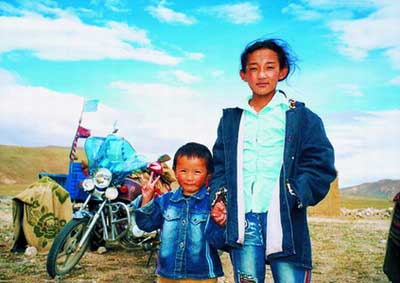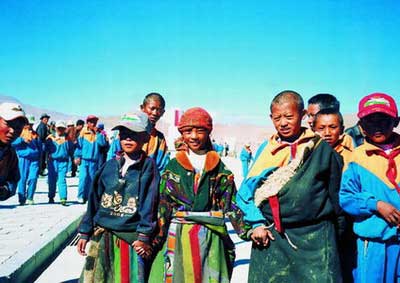Source: tibet.cn
09-06-2007 18:39
 |
Editor's Note Ngari, sited at an average elevation of 4,500 meters, is often mentioned as "roof on the roof of the world". Half a century ago it was still an isolated and underdeveloped place typified by extreme poverty. Today, some of the greatest changes in the history are quietly taking place there.
In the late summer of 2004, we set off from Lhasa and, after driving thousands of kilometers, visiting seven counties, in about a month. The following is what we saw there.
On Way to Rich Life
After a long journey, our car passed through the clay forest grand canyon, and came to one of the most significant cradles of ancient Zhangzhong Culture-Zada County in the western tip of Ngari. In Tibet, the Guge Kingdom existed more than 1,000 years ago. And, today, what we can see the current situation of the lives of Guge's offspring in early of 21st century.
Zaburang is under Zada County's Toding Town and is the closest village to the Guge Ruins. When we entered the village, we saw many giant poplar trees, a rare sight in Zada County.
Before 1978, these villagers still lived in caves. Since then, however, they have seen great changes in their lives.
A pretty Tibetan girl led us to the home of Neighborhood Committee chief Norjor. He has led the way in becoming rich in Zaburang Village and was awarded the title of Outstanding Youth by the Tibet regional, Ngari prefecture and Zada County governments one after another. In 1993, he was elected head of Toding Township. In 1999, he became chief of the Toding Neighborhood Committee.
Norjor said "In 1982, I borrowed 19,000 Yuan from the bank and purchased a Jiefang truck to do transportation business. Many villagers followed suit."
 |
"Our village now owns nine motor vehicles. There are many poor households. We have sent domestic animals and food to them and have organized the village to build new houses for them. We also did something to improve the strain of cattle. In the past, the local cattle produced little flesh and the milk was of poor quality. Since 2001, we have introduced Ximoinda and striped white cows from Xigaze with the help of the local livestock bureau."
After several years of endeavor, Zaburang Village has completely got rid of poverty.
In recent years, when many came to visit the Guge Kingdom ruins, Norjor mobilized the villagers to open buttered teahouses, restaurants and hotels. At the foot of the Guge Ruins, a modern rural economic developing mode is emerging with the integration of an ethnic handicraft industry, textile industry, local food and drink, and ethnic dance and singing, so that the offspring of Guge are creating new lives in the 21st century.
